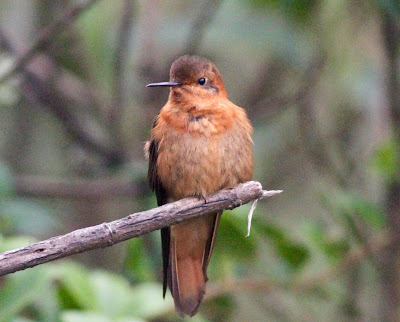Monday, July 17 - PNN Los Nevados
After leaving Risalda Province for the first time we drove up to the city of Manizales, perched precariously along a ridge with steep drops, and roads, on either side. After a night in a hotel and the national coffee growers trade association headquarters (hot water!) we headed up for a full day in PNN Los Nevados. The weather initially looked worrying, and while the morning was freezing cold, and dogged by drifting fog and low clouds, we did manage to get some serious birding in nevertheless.
The drive up looked promising and indeed we made several very productive stops for Paramo Seedeater, Paramo Tapaculo and Golden-breasted Puffleg.
 |
| Visibility came and went but we still saw some good birds like Golden-breasted Puffleg. |
We had a specific target bird in mind through so pushed up past the tree-line and soon were in the Paramo habitat proper (when we could see it between the drifting clouds that blotted out all visibility on regular intervals). The birds here changed too, with Stout-billed Cinclodes, Many-striped Canastero and Tawny Antpittas joining the mix.
 |
| Many-striped Canastero |
 |
| Buffy Helmetcrest |
 |
| Black-throated Flowerpiercer |
 |
| Shining Sunbeam and Rainbow-beared Thornbill |
July 18 - 19 - Reserva Ecológico Río Blanco
Another famous reserve that I'd really been looking forward to visiting and with two full days, and a bunch of target (life) birds to chase, so good birding was hopefully ahead of us as we arrived on Tuesday morning.
Rio Blanco is famous for Antpittas, not just any old antpittas though, but rather several rare species of antpitta that have been painstakingly habituated to come to 'feeding stations' to eat worms placed out by the lodge staff. Within minutes of arriving, we were joined by a local guide/volunteer and accompanied her on the daily routine of feeding the antpittas. First up, the near endemic Bicolored Antpitta which eventually appeared in a shady clearing under a tree after a good five minutes of whistling and quietly waiting. These birds didn't just pop up for their lunch, they remained mostly cautious and quite wild. The Slate-crowned Antpitta and the endemic Brown-banded Antpitta were similarly cautious, but the more common Chestnut-crowned Antpittas were positively tame and hopped around our feet while waiting for their worms, one even allowing me to feed it by hand (!). I gather this method of habituating birds has its critics .... I'm not really going to comment on it, but I did have a lot of fun seeing very close antpittas ....
 |
| The super tame Chestnut-crowned Antpitta and the somewhat shyer Slate-crowned Antpitta |
 |
| The endemic Brown-banded Antpitta |
 |
| Not a perfect photo, but my first ever photo of Ocellated Tapaculo. |
We also did a little night-birding one day, but had nothing terribly rare to report - just White-throated Screech-Owls and Rufous-banded Owls. Later we made a quick one-night stop at Hotel Tinamou, adding a few additional species to make the total for Caldas Province a very respectable 262 species for a few days of birding.
 |
| Bronzy Inca and White-bellied Woodstar |





No comments:
Post a Comment